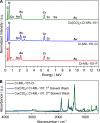Heterogeneous Epoxide Carbonylation by Cooperative Ion-Pair Catalysis in Co(CO)4--Incorporated Cr-MIL-101
- PMID: 28573206
- PMCID: PMC5445536
- DOI: 10.1021/acscentsci.7b00075
Heterogeneous Epoxide Carbonylation by Cooperative Ion-Pair Catalysis in Co(CO)4--Incorporated Cr-MIL-101
Abstract
Despite the commercial desirability of epoxide carbonylation to β-lactones, the reliance of this process on homogeneous catalysts makes its industrial application challenging. Here we report the preparation and use of a Co(CO)4--incorporated Cr-MIL-101 (Co(CO)4⊂Cr-MIL-101, Cr-MIL-101 = Cr3O(BDC)3F, H2BDC = 1,4-benzenedicarboxylic acid) heterogeneous catalyst for the ring-expansion carbonylation of epoxides, whose activity, selectivity, and substrate scope are on par with those of the reported homogeneous catalysts. We ascribe the observed performance to the unique cooperativity between the postsynthetically introduced Co(CO)4- and the site-isolated Lewis acidic Cr(III) centers in the metal-organic framework (MOF). The heterogeneous nature of Co(CO)4⊂Cr-MIL-101 allows the first demonstration of gas-phase continuous-flow production of β-lactones from epoxides, attesting to the potential applicability of the heterogeneous epoxide carbonylation strategy.
Conflict of interest statement
The authors declare the following competing financial interest(s): The authors and MIT have filed a patent on some of the results herein.
Figures


Similar articles
-
Continuous-Flow Production of Succinic Anhydrides via Catalytic β-Lactone Carbonylation by Co(CO)4⊂Cr-MIL-101.J Am Chem Soc. 2018 Aug 29;140(34):10669-10672. doi: 10.1021/jacs.8b05948. Epub 2018 Aug 16. J Am Chem Soc. 2018. PMID: 30096234
-
Hyper-Cross-Linked Porous Porphyrin Aluminum(III) Tetracarbonylcobaltate as a Highly Active Heterogeneous Bimetallic Catalyst for the Ring-Expansion Carbonylation of Epoxides.ACS Appl Mater Interfaces. 2019 May 22;11(20):18609-18616. doi: 10.1021/acsami.9b02468. Epub 2019 May 9. ACS Appl Mater Interfaces. 2019. PMID: 31039304
-
Brønsted-Lewis dual acid sites in a chromium-based metal-organic framework for cooperative catalysis: Highly efficient synthesis of quinazolin-(4H)-1-one derivatives.J Colloid Interface Sci. 2020 Mar 1;561:782-792. doi: 10.1016/j.jcis.2019.11.056. Epub 2019 Nov 16. J Colloid Interface Sci. 2020. PMID: 31761467
-
Advances in Catalyst Design for β-Lactone Formation via Ring-Expansion Carbonylation.Molecules. 2025 Mar 21;30(7):1399. doi: 10.3390/molecules30071399. Molecules. 2025. PMID: 40285854 Free PMC article. Review.
-
Asymmetric catalysis of epoxide ring-opening reactions.Acc Chem Res. 2000 Jun;33(6):421-31. doi: 10.1021/ar960061v. Acc Chem Res. 2000. PMID: 10891060 Review.
Cited by
-
Grand Challenges and Future Opportunities for Metal-Organic Frameworks.ACS Cent Sci. 2017 Jun 28;3(6):554-563. doi: 10.1021/acscentsci.7b00197. Epub 2017 Jun 6. ACS Cent Sci. 2017. PMID: 28691066 Free PMC article. Review.
-
Reticular Chemistry in All Dimensions.ACS Cent Sci. 2019 Aug 28;5(8):1295-1300. doi: 10.1021/acscentsci.9b00750. Epub 2019 Aug 6. ACS Cent Sci. 2019. PMID: 31673626 Free PMC article. No abstract available.
-
Computational Design of Functionalized Metal-Organic Framework Nodes for Catalysis.ACS Cent Sci. 2018 Jan 24;4(1):5-19. doi: 10.1021/acscentsci.7b00500. Epub 2017 Dec 21. ACS Cent Sci. 2018. PMID: 29392172 Free PMC article. Review.
-
Enhancing the Catalytic Activity in the Solid State: Metal-Organic Frameworks to the Rescue.ACS Cent Sci. 2017 May 24;3(5):367-368. doi: 10.1021/acscentsci.7b00161. Epub 2017 Apr 25. ACS Cent Sci. 2017. PMID: 28573196 Free PMC article. No abstract available.
-
A Metalated Porous Porphyrin Polymer with [Co(CO)4]- Anion as an Efficient Heterogeneous Catalyst for Ring Expanding Carbonylation.Sci Rep. 2018 Sep 5;8(1):13243. doi: 10.1038/s41598-018-31475-6. Sci Rep. 2018. PMID: 30185794 Free PMC article.
References
-
- Pommier A.; Pons J. M. Recent advances in β-lactone chemistry. Synthesis 1993, 1993 (5), 441–459. 10.1055/s-1993-25878. - DOI
-
- Wang Y.; Tennyson R. L.; Romo D. β-Lactones: intermediates for natural product total synthesis and new transformations. Heterocycles 2004, 64, 605–658. 10.3987/REV-04-SR(P)3. - DOI
-
- Müller H. M.; Seebach D. Poly(hydroxyalkanoates): a fifth class of physiologically important organic biopolymers?. Angew. Chem., Int. Ed. Engl. 1993, 32, 477–502. 10.1002/anie.199304771. - DOI
-
- Mori Y.; Tsuji J. Organic syntheses by means of metal complexes. III. cobalt carbonyl-catalyzed carbonylation of β-propiolactone. Bull. Chem. Soc. Jpn. 1969, 42, 777–779. 10.1246/bcsj.42.777. - DOI
LinkOut - more resources
Full Text Sources
Other Literature Sources

